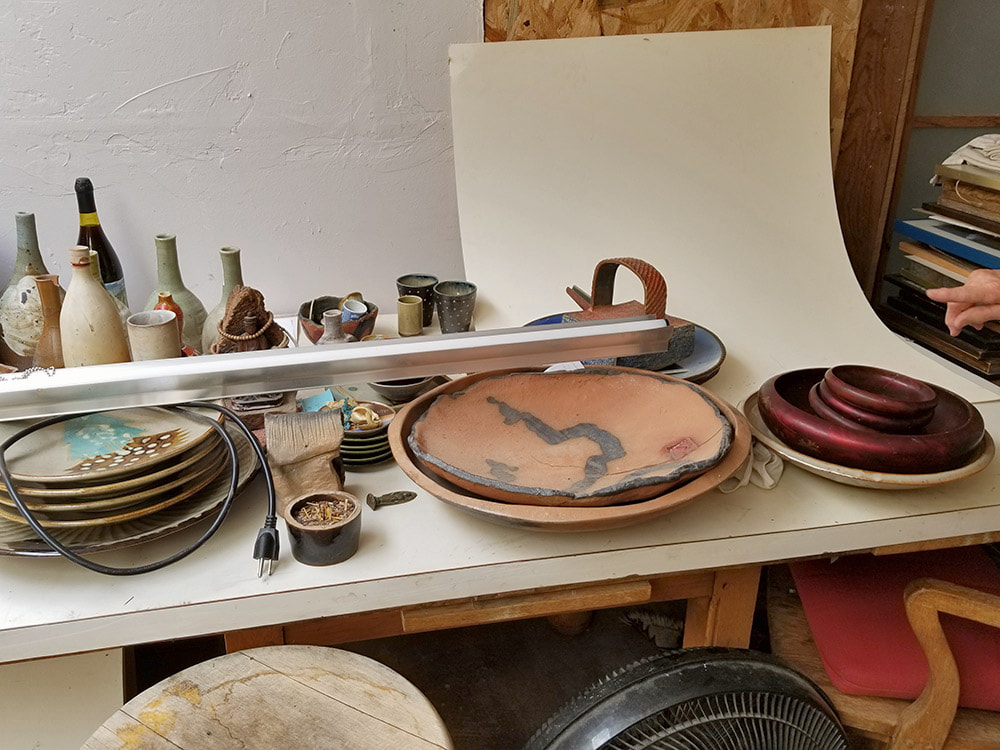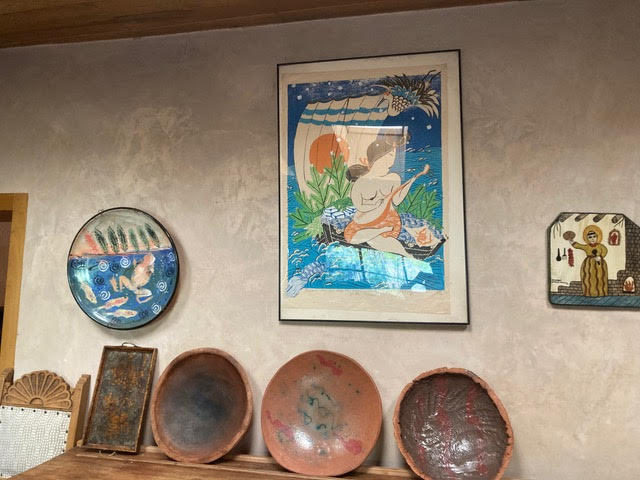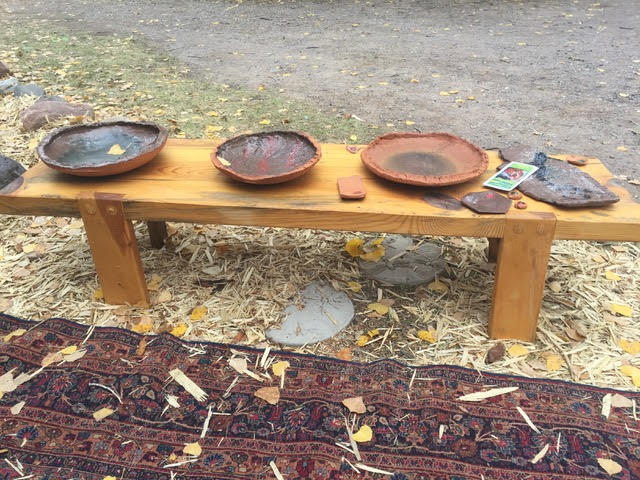|
Lisa Faithorn and her husband Djann Hoffman had a vision when they moved to Medanales: they wanted to create a community-focused space which would foster environmental stewardship, local engagement, and artistic expression. In 2006, they bought a 20-acre farm by the Chama River, “long and narrow, like most of the farms around here”, Djann told me when I visited them. “We have an acequia that runs right across the middle, a very old ditch from the 1600s. But we didn't really know we were going to bring the farm back to life when we moved here!” Of course I wanted to find out where they had moved from. It turned out that Djann had lived in El Rito for almost ten years in the 1970s, homesteading and weaving – ("I was a hippie then”, he said). He left for California in 1979, and that’s when he met Lisa. After give or take 25 years they both felt it was about time to leave the state, although they had a lovely house in Walnut Creek. The Bay Area was becoming too noisy and too crowded. They were looking all over the map, searching for the location of their new home. Djann still owned the cabin in El Rito which he and his son Josh had resurrected,, but it was up in the mountains on a bad dirt road. It wouldn’t be suitable for Lisa. “I was working for NASA at the time, on a project based in Houston, and I had to fly there for a week at a time”, she told me. “I needed to be near enough to an airport, and I needed the internet, plus I wanted to garden. The El Rito cabin was too high up in the Ponderosa forest for that. At first, we were looking for a place to garden, not a farm”. Djann found the location where they’re now with the help of a realtor, but he wasn’t sure whether Lisa would like it. It seemed too big, with several studios and outbuildings. But they had dreams of a larger community, of people coming to join them here, and when Lisa met Djann to look at the place she fell in love with it. This is what she told me: “That first summer we arrived in July, and it was hot. We would walk every day, just getting to know the property. And one big field out here was filled with little elm trees because it hadn't been farmed for at least forty years; the previous owners were artists”. “So we were on one of our daily walks, and I actually heard a voice that said, ‘I'm a farm, wake me up’. Now, I don't know if you can put that in the article, people will think I'm a little nuts, but that's actually what happened. We felt like this land spoke to us”. Well, I for one don’t think that Lisa is nuts, because I’ve had similar experiences. I believe that we humans don’t hear a lot of things; partly because of all the noise we make, and partly because we don’t really listen. Lisa continued: “Djann felt it too, and he said, ‘if we're going to do that, we have to do it right: conserving water, using solar energy, and planting organic’. So that's what we dove into”. They hired a neighbor with a tractor who lived down the road, and she pulled all the elm trees out of the field. After a cover crop, Lisa and Djann planted garlic. They got bulbs from Stanley Crawford in Dixon and had great results. There also was a big orchard with about twelve old apple trees, and in the second year they planted lots of grapes which they got from Stan Bader at Las Parras. In addition, they put up a couple of hoop houses and started to grow vegetables, also during the winter. But it was a lot of work for just two people. Lisa explained: “I had a full-time job, and Djann was a working artist. There were only so many hours a day we could dedicate to the farm, plus, we didn’t have much solid knowledge. We decided to keep growing healthy food for ourselves and others, and see what would happen”. Djann was still building furniture and doing pottery. I wanted to hear more about this. “I was building furniture like these pine-slab tables–” Djann pointed to the table we were sitting on, and to another one in the room – “and I've been doing pottery for a long time. I use micaceous clay (which I buy in Santa Fe) and throw by hand, mostly dishes and big platters, and they get fired in a campfire or an electric kiln”. “He has a kiln and a pottery studio”, Lisa added. “Part of our vision here was not only producing food, but also art and healing. We imagine this is a center for art and healing and education and agriculture. We've had healers in residence, and we've had artists in residence over the years. People who’ve stayed in our casita fell in love with the place, and some of them were teachers, and they asked, ‘Can I bring my students here?’ And so we had an Adobe class here, we had a yoga class, and we had a group of archeologists stay here”. Djann shared the next chapter in the Farmer Saga. “Two years ago, we met a young couple who had recently moved to Abiquiú. They had been successfully farming in Taos and had a steady market. for four or five years, and did a really good job. They started farming on their new land in Abiquiú, but there were some issues with water rights. A friend told them to contact us because we had an irrigated field and two hoop houses on the land that we weren’t using. So we met and agreed to lease the land to them. They’re in their early 30s , I think, and have incredible energy! They began working immediately, covered those two greenhouses, and within three weeks they had filled them with plants. And in six weeks they were selling produce”. LIsa added: “They're phenomenal growers, they call their business ‘Umami Gardens’. They sell at the Taos Farmers Market, and more recently at the Santa Fe Farmers Market, and supply several restaurants”. Maybe they would be an interesting topic for a future Abiquiú News article! Djann was successfully growing hemp for three years, but then the market tanked because there were too many people in the business. Farside Farm was growing medicinal hemp, and Djann and his friend Cat Stanley learned to produce a painkilling salve. They also developed a mosquito spray that soothes mosquito bites and heals red ant bites. It's made from hemp that is infused into aloe vera over four or five weeks, strained, and then turned into a spray. When it’s mixed with some coconut oil and beeswax, it becomes a salve which is a great topical pain killer and has anti-inflammatory properties. “Actually, somebody bought some of my distilled hemp oil stash a few weeks ago because they're working on cancer tumors, treating cancer tumors with CBD salve”, Djann continued. “We're beginning to develop our own products, which we can soon sell online or around the neighborhood. We had our crop distilled, turned into a syrup, and frozen, so we have enough hemp for about ten years ”. Both the salve and the spray sound amazing. They help with arthritis, with sore muscles, and muscle aches in general. Lisa has her own big garden she tends to. She’s growing vegetables and lots of flowers. “It’s a meditative, healing thing to do”, she said. We briefly reminisced about the different growing conditions in the San Francisco-Bay Area, where we both had lush, beautiful gardens. I remember that I spent a good deal of my time trimming and cutting back; everything was growing so fast that one could easily end up with a colossal jungle. Lisa agreed: “It was quite a learning curve for me, too, making that shift. The climate is completely different. It’s mostly sand here, but we’ve been putting in organic additives over the years, and there are a lot more worms now, and we have many pollinators”. Lisa’s garden is thriving. Djann has a number of other projects he pursues. One of them: he collects pottery, besides throwing pots himself. He has been collecting pieces for over 40 years, and most of them are Japanese, because of his study and practice of Japanese Tea Ceremony. When he lived in the Bay Area he took classes at one of the Zen Centers there. That’s when he learned to appreciate the beauty of the pottery items being used. He’s currently starting to photograph his vast collection. Both he and Lisa have been to Japan several times, that’s where he acquired an eye for good Japanese pottery, Djann told me. Both Lisa and Djann also collect prints, first and foremost by acclaimed Japanese artist Mayumi Oda. And at this point, I must inject a personal note: my wonder about the serendipitous connections I’ve had with this couple. Lisa Faithorn was a professor at the California Institute of Integral Studies (CIIS), a university in San Francisco where I got my Master’s and completed the course work for a PhD. I took a class about Deep Ecology with her in 1996 which I enjoyed a lot. Beyond that, I had no personal connection with her; imagine my surprise when I met her again at an alumni event in 2006 or so when I discovered that both she and I now lived in or close to Abiquiú! And when Djann mentioned that he collects prints from Mayumi Oda, I remembered that I had met her several times when I lived in Berkeley/CA. She was good friends with the owner of the futon store where I worked, a Japanese expatriate who had gathered around her a small diaspora of similar-minded, strong and independent Japanese women and their spouses. I connected with them because I had met one of them, a woman I knew from Kyoto, walking down the street in Berkeley. What a small world. Back to Lisa and Djann’s collection of Mayumi Oda prints. Djann told me: “I currently have some framed, and we're working with the Zen Center in Santa Fe, the Upaya Zen Center and Roshi Joan Halifax. She's from California and we've known her for a long time. They've got a huge new Zendo there, and so she's going to sell the prints to make money for the Zen Center. So that's another project”. “Over the years, we collected quite a few other prints, some Japanese, some American wood blocks. I've always really liked wood blocks, and I collected a lot of scrolls which I bought in California. I had a delivery company for medical records where I drove all over the Bay Area”. Lisa elaborated: “Djann had a law degree and was with a law firm for a couple of years, but then he realized that he didn't really like the work. So he started a legal courier business, a delivery service for medical records and legal papers. It was before fax machines. So there was a lot of driving around, and that’s how he started this collection, which he calls ‘Found in the West’. All this is the Art part of the Art, Agriculture, and Healing basis of our farm”. “I'm so happy to have younger people do the farming now”, Djann continued. “Not only do they have the energy, but they are highly skilled and informed in a way that we never could be, and it's their passion. We've been here almost 18 years now, but the property had been abandoned as a farm for 40 years. It’s good to see it come back to life”. Lisa explained her philosophy to me, as far as the farm is concerned. “I'm an anthropologist and have a PhD in anthropology. After living in Papua, New Guinea with indigenous people and seeing what the Western world was doing to indigeneity, my focus shifted back to the US, social justice and the environmental crisis. So somehow being here in this landscape and providing the way for this farm to thrive and for people to benefit, I hope to counter in some small way the negative forces that have destroyed so much of the planet. My focus was very global for a long time, and living here is a much more local focus; it's satisfying to me to see things come back to life”. “There are so many young people moving into this area now”, she went on. “We had a wonderful couple live in our casita, they just bought a house. They're in their 30s, they fell in love with this area during the pandemic because they could work remotely. Through them, we’ve met other newcomers, and we noticed that a lot of people moving here are much younger, who are buying farmland and want to farm, not just live there”.
It’s so comforting to know that Lisa and Djann’s vision to have a sustainable farm which supports and attracts growers, artists, and healers is taking shape and blossoming. Thank you for providing us a glimmer of hope when the climate crisis and other realities can overshadow our view of the future.
6 Comments
11/15/2024 08:12:33 am
Lisa & Djann are my neighbors.their farm is exceptionally beautiful and so are the people.very good article Jessica.
Reply
Jessica Rath
11/18/2024 03:53:22 pm
Thank you, Renata! Yes, "exceptional" is a good word, that's exactly the impression I had after I visited Lisa and Djann.
Reply
Jane Sheridan
11/15/2024 12:19:53 pm
I manage a cattle ranch north of Regina. Also interested in farming and Japanese pottery. I have spent 35 years irrigating hay farms out of acequias in northern NM. I grew up ranching on old days Kauai.Did I miss a website for these folks?
Reply
Jessica Rath
11/18/2024 04:01:41 pm
Hello Jane, they used to have a website, but it's gone. I did find a blog, though: https://farsidefarmblog.wordpress.com/
Reply
Celeste Berteau
11/19/2024 12:07:06 pm
What a wonderful article about two of my favorite people! A lovely surprise. Thank you.
Reply
Beth
11/19/2024 01:28:06 pm
I cannot wait to live in the area so I can support all of the amazing people in and around the community.
Reply
Your comment will be posted after it is approved.
Leave a Reply. |
Submit your ideas for local feature articles
Profiles Gardening Recipes Observations Birding Essays Hiking AuthorsYou! Archives
October 2025
Categories
All
|






 RSS Feed
RSS Feed